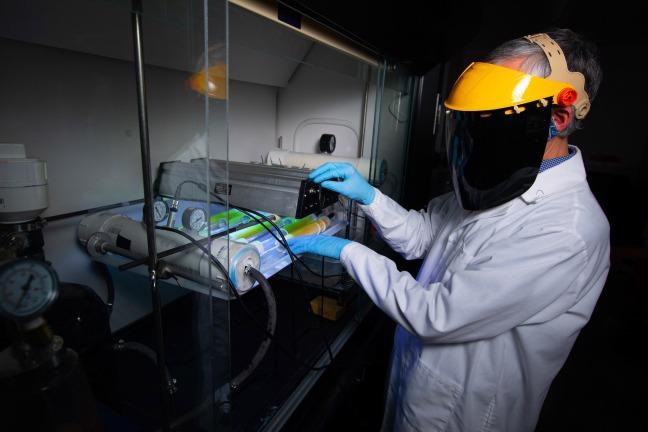Feb 25 2021
Let there be (ultraviolet) light. That is the indication provided by a study performed at Iowa State University (ISU) relating to the use of ultraviolet light(UV) to stop the spread of the virus that is responsible for causing the porcine reproductive and respiratory syndrome (PRRS).
 Jacek Koziel adjusts infrared lamps and sensors in a Sukup Hall laboratory. Experiments on infrared light show that it’s capable of mitigating the spread of the virus that causes the porcine reproductive and respiratory syndrome. Image Credit: Christopher Gannon.
Jacek Koziel adjusts infrared lamps and sensors in a Sukup Hall laboratory. Experiments on infrared light show that it’s capable of mitigating the spread of the virus that causes the porcine reproductive and respiratory syndrome. Image Credit: Christopher Gannon.
PRRS is an expensive swine disease that can transmit through the atmosphere. Laboratory experiments have demonstrated that the radiations induced by certain kinds of UV light destroy the viral particles contained in aerosolized droplets, and the investigators are hoping to improve their tests to demonstrate how their strategy could work on a farm.
Being an infectious swine disease, PRRS costs pork producers about $580 million back in 2016. This virus is known to spread either by viral droplets carried in the atmosphere or by direct contact between pigs.
Such droplets can continue to remain in the atmosphere for many days and can travel very long distances on air currents, thus rendering it difficult to contain the virus.
A PRRS-infected sow may not probably carry the offspring to term, and young pigs afflicted with this disease experience respiratory distress that delays their growth and renders them more vulnerable to a host of other diseases.
To mitigate the viral spread, a few pork producers install expensive air filtration systems in their barns; however, the ISU team is searching for less costly methods.
Jacek Koziel, a professor of agricultural and biosystems engineering, has explored the advantages of utilizing UV light—a spectrum of light that has very short wavelengths for the human eye to spot—to remove dust as well as odor-causing particles linked to the production of livestock.
It has been demonstrated that UV light irradiates and disrupts the RNA of certain bacteria, and Koziel speculated whether an analogous technology could tackle the viral aerosols.
Conventional UV is known to be bactericidal. UV has been used to kill bacteria in the food industry in many instances. The same mechanism is actually beneficial to kill the virus.
Jacek Koziel, Professor, Department of Agricultural and Biosystems Engineering, Iowa State University
Lab Results
Koziel has teamed up with Jeff Zimmerman, a professor of veterinary diagnostic and production animal medicine, who has extensively worked with various aerosolized viruses, including PRRS.
In a Sukup Hall laboratory, the team performed experiments and subjected the virus to three forms of UV light.
In these experiments, live virus samples were aerosolized and the air was subsequently pumped via glass tubes that enable UV light to pass through.
The team then measured the extent to which the virus tolerates the exposure to UV light.
The three kinds of UV light examined in the research work included traditional UV light, called UV-C; UV-A light, occasionally called near-visible black light; and light from innovative excimer lamps that emit light with particularly short wavelengths.
Both the excimer UV light and the traditional light had the potential to deactivate the virus and could offer a potential way to combat PRRS. While exposure to UV light can pose a risk for both pigs and humans, the excimer light used in the analysis has been demonstrated to be less dangerous.
According to the study, the black light, which has been demonstrated to be useful in reducing the odor-causing gases, did not have a major impact on the PRRS virus.
Next Up: Testing on a Larger Scale
According to Zimmerman, UV light may provide veterinarians and pork producers a novel tool to prevent or reduce the disease. To prevent aerosolized viruses from entering their operations, a few farmers typically install costly ventilation systems in their barns but such measures come with a heavy price tag, Zimmerman added.
It’s very costly to implement, and then there are ongoing maintenance concerns with making sure the buildings are airtight. The filters themselves are expensive and filter maintenance is not cheap. Ultraviolet fixtures could offer greater flexibility.
Jeff Zimmerman, Professor of Veterinary Diagnostic and Production Animal Medicine, Iowa State University
The team hopes to improve their studies to test the ideas under conditions that imitate a swine facility more closely. In fact, Koziel has envisioned a system, in which UV lamps are set up close to ventilation intakes to ensure that air entering the area does not carry the aerosolized virus.
Zimmerman added that he is looking forward to a growing interest among pork producers if the researchers can demonstrate that their method works equally well in barns as it does in laboratory settings.
The study was financially supported by the National Pork Board.
Researchers killing PRRS virus with UV light to protect pigs
Video Credit: Iowa State University.